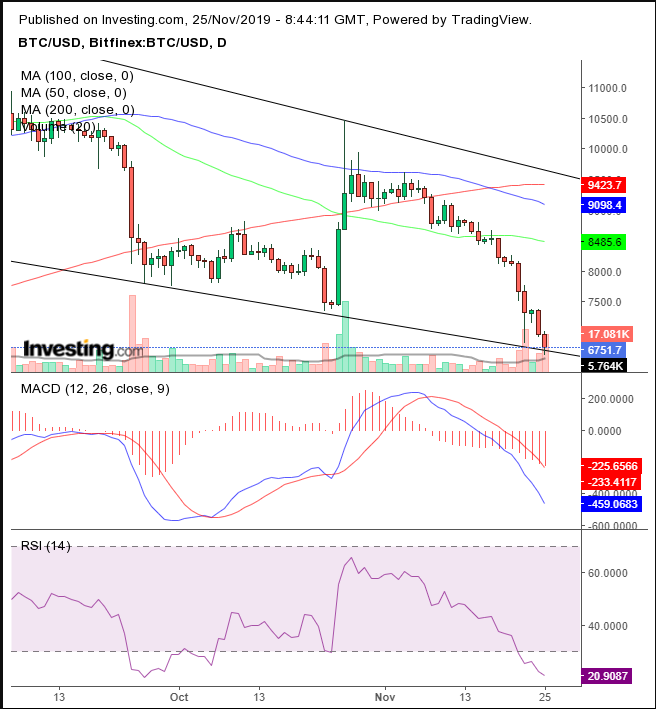Bitcoin is dropping again, its seventh straight losing session out of 10, pushing the price to below the $7000 mark for the first time in six months. Why now?
Here are some possible reasons:
- Concerns over a Chinese crackdown, this past Friday, on both trading and issuing cryptocurrencies.
- Low volume trading, allowing big players to move the price.
- Optimism over a trade deal that is keeping equity prices at record levels, at the expense of safe havens.
- Miner capitulation: when mining machines become too expensive relative to falling payouts.
For many who own and trade digital currencies it's more than an investment, it's a way of life. Some see other drivers:
- Oliver Renick claims, in an article in Forbes, that the most popular cryptocurrency by market cap hasn’t been crashing because of China but because “you don’t need it.” He cites its volatile nature and the fact that adoption of the asset class is simply not happening, with big tech companies steering instead toward creating their own cryptocurrencies.
- It may be that Bitcoin’s low volume is due to rotation into traditional assets amid record equity prices, as risk appetite grows with hopes of a trade resolution, at the expense of havens. The issue with this argument is that while havens are retreating today, yields, gold, the yen and the Swissy have not sold off anywhere near what the cryptocurrency has.
- Cointelegraph and the Asia Times both ran similar articles yesterday, based partly on information from Coin Dance, which monitors Bitcoin hash rates, positing that miners are, in fact, “unfazed” by the Bitcoin price crash.
One of Bitcoin’s key selling points is the fact that it’s unregulated. That means neither governments nor investors really know what’s going on. Our bet then is that each of these points have some contributing influence over traders, even if it's just solely about sentiment.
Perhaps then, it's most prudent to simply keep tracking the balance of supply and demand, whether driven by fundamentals or not.

Bitcoin has been trading within a falling channel since the June 26, $13,764 high. Today, it dipped below the lower boundary of the channel for the first time in its duration. However, for now, it's bounced back above, suggesting support.
The drop is very hard, as shown by the volume, the second biggest selling volume (after Friday’s) since Sept. 24. This dispels the argument that low volume is responsible for the big moves. Indeed, volume has been broadly muted since the bubble burst in late 2017.
Exactly one month ago, the 200 DMA climbed over the 50 DMA, triggering a death cross, proceeding to cross over the 100 DMA, forming the triple, bearish pattern.
With the MACD low and the RSI at its lowest since September, as the price is finding support, it may be time for either a return move to the channel top or for a downside breakout, with a filter to avoid a bear trap. This would be followed by a return move that would confirm the channel bottom’s new resistance.
Trading Strategies
Conservative traders would wait for a full pullback to the channel top, confirmed with at least one long red candle from the very top.
Moderate traders would wait for a return move until the correction weakens.
Aggressive traders may enter a contrarian trade and go long on the potential bounce.
Trade Sample
Which stock should you buy in your very next trade?
With valuations skyrocketing in 2024, many investors are uneasy putting more money into stocks. Unsure where to invest next? Get access to our proven portfolios and discover high-potential opportunities.
In 2024 alone, ProPicks AI identified 2 stocks that surged over 150%, 4 additional stocks that leaped over 30%, and 3 more that climbed over 25%. That's an impressive track record.
With portfolios tailored for Dow stocks, S&P stocks, Tech stocks, and Mid Cap stocks, you can explore various wealth-building strategies.
